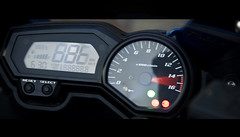Digital Speedometer just like KITT
Tags: books devops monitoring
KITT captured my imagination when I was four years old. If you weren’t a child of the 80’s, you may not know the depths of KITT’s awesomeness. Gaze carefully at his feature list and try to control the swell of emotions that stir deep within you. A “Molecular Bonded Shell”, a “Third Stage Aquatic Synthesizer”, “Passive Laser Restraint System”, a built-in ATM, and an artificially intelligent personality voiced by Mr. Feeny. I wanted a Firebird or Trans Am for years after seeing KITT in action.
Around the same time that KITT was on television, my dad was shopping for a new vehicle to replace his incredibly crappy Buick Skylark. Although he eventually purchased a totally plain and perfectly suitable Dodge Ram pickup truck, he considered a couple of different options before signing on any dotted lines. I’m fairly certain he test drove a Dodge Daytona, and it mesmerized me. It had a bright, digital dashboard reminiscent of KITT’s. The steering apparatus was a totally boring wheel, but I was willing to overlook it. Not every car can have a yoke.
Decades later I rented a car with a digital dashboard. Once the novelty wore off, I was disappointed with the utility of it all. The two digit speed display required reading. I couldn’t keep tabs on my speed with my peripheral vision quite like I could in cars with analog dials.
An analog gauge, whether physically analog or digitally rendered, provides the moment in time value along with the context of expected and potential ranges. For instance, the tachometer below shows a potential range of 0 through 16 thousand RPM, but the area between 14K and 16K are clearly marked to indicate potential trouble from running within that range:
Sidney Dekker talks about this briefly in chapter 14 of The Field Guide to Understanding Human Error. He claims that numeric digital readouts
“can hide interesting changes and events, or system anomalies.”
Why is it, then, that I have produced so many monitoring scripts that produce little more than a two, or three, or four digit number as output? The raw numbers are necessary but not sufficient for use in a production support situation. The numbers must feed into a system that will graphically provide context over time.
One last thing. It’s OK if you got a little misty eyed when KITT was dropped into a pit of acid.
